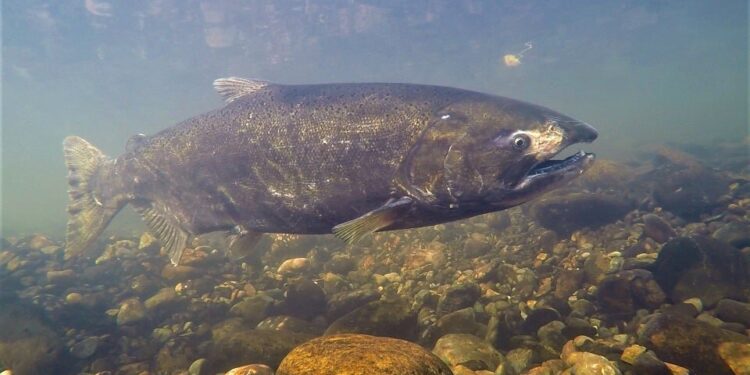Human activities are disrupting the reproductive success and habitat of Chinook salmon like this one. Credit: Joe Merz, UC Davis
Chinook salmon face unprecedented challenges as their once-thriving populations struggle to survive. A new study published in the journal Ecosphere suggests that decades of human activities, including offshore harvesting, artificial propagation, and reservoir construction, have not only reduced the size of these fish, but also disrupted their ability to spawn successfully.
Joe Merz, lead author of the paper and an affiliated researcher in the Department of Wildlife, Fish and Conservation Biology at UC Davis, said that Chinook salmon play a crucial role in their ecosystems and that management of Fisheries and habitat changes have weakened their natural reproductive potential.
“We have an organism that uses a variety of ecosystems during its life cycle,” Merz said. “We tend to divide these ecosystems and manage them separately. As a society, we need to think more holistically about what will benefit our fish populations.”
Restoring natural spawning habitats
Chinook salmon migrate from the ocean to freshwater streams where they are born to spawn. Females find suitable nesting sites, usually in gravel beds, to lay their eggs and move the gravel with their tails to cover and protect them until they hatch.
Merz, who is also president and principal scientist of Cramer Fish Sciences, and the team of researchers analyzed more than 100 years of data on Chinook salmon growth trends, with a focus on the Lower American River , which historically supported spring and fall Chinook salmon runs. They found that salmon length generally declined, fluctuating with rates of sea harvest and hatchery production.
Reduction in size, combined with deteriorating habitat conditions caused by numerous human impacts, including mining and dam construction, has made the river gravel too large for small salmon to handle. move and use it efficiently. To further complicate spawning, dams also block salmon from their historic habitat and alter water flow.
“The average female Chinook salmon can move two cubic meters of gravel while she’s nesting in the river; she can essentially change the bed of the river,” he explained. “This is an important thing because it increases habitat complexity and influences the aquatic insect community, an important part of the river food web. And what concerns me is that we are decoupling an organism from its natural spawning cycle in our rivers.”
The research team conducted tests adding different sizes of gravel to spawning sites and determined that spawning activity was increased with smaller gravel. Merz said effective management strategies could involve adjusting hatchery or harvesting practices, restoring spawning sites with smaller river gravel and protecting ecosystems.
“This study shows that we can make change in different ways, and giving people options helps remove barriers,” he said.
Have a positive impact
Nann Fangue, professor and chair of the Department of Wildlife, Fish and Conservation Biology, highlighted how this solutions-focused research translates scientific discoveries into real-world benefits.
“Work that addresses key conservation questions, such as how we can improve spawning habitat for threatened and endangered fish, is central to our department’s mission,” Fangue said. “This type of research translates scientific understanding into practical steps that directly contribute to the recovery of important species like Chinook salmon.”
For Merz, studying the key factors that keep salmon populations healthy, such as genetic diversity and body size, clean water, open migration routes and sustainable fishing, is essential and he hopes it can help guide conservation efforts and restore ecosystem services to support this. endangered species.
“I have hope,” he said. “As we continue to do research and better understand these relationships, it provides us with opportunities and options for management strategies, and that encourages me.”
More information:
Joseph E. Merz et al, Disruption of the natural disturbance regime decouples the habitat and life stage of a keystone species, Ecosphere (2024). DOI: 10.1002/ecs2.70017
Quote: Chinook salmon face unprecedented habitat challenges due to human-caused changes, research suggests (October 14, 2024) retrieved October 14, 2024 from
This document is subject to copyright. Except for fair use for private study or research purposes, no part may be reproduced without written permission. The content is provided for informational purposes only.



